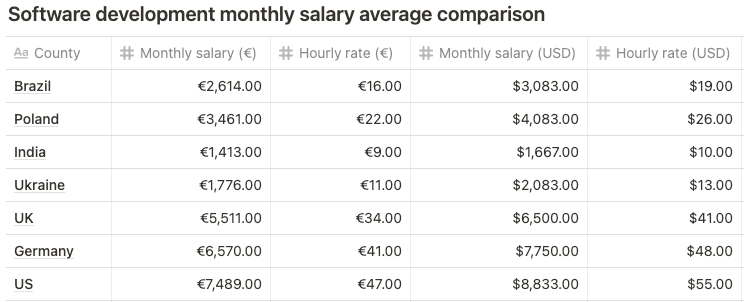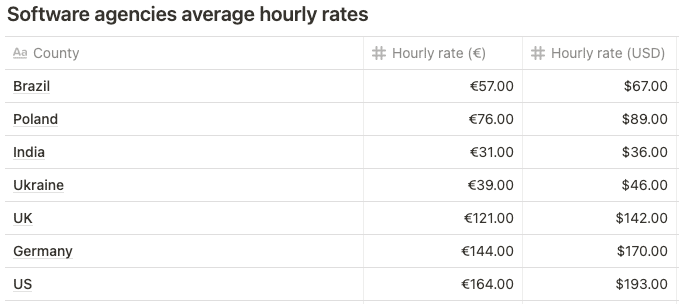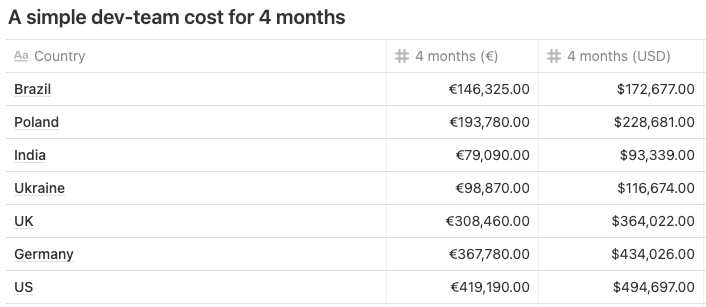Working with digital products is pleasurably intensive, especially in a software agency that builds custom-made solutions. The amount of people I get to meet with innovative ideas and futuristic visions is unprecedented. It’s beautiful to see entrepreneurs willing to solve relevant problems locally or globally, in startups or large corporations; the ideas inspire me to do what I do and write this article.
After 11 years working with digital solutions (and the past two and a half with custom-made ones), the number one question I most get is “How much will it cost to build the MVP of my digital product?”. Have you ever asked yourself this question?
I had the same question in my mind nine years ago when I interviewed many software agencies to make my vision come true, and I wish I knew then what I am sharing with you today
The first question to ask yourself is ‘do you need custom software?‘. If your budget is limited, and you still need to validate the value proposition of your product, choosing bootstrap solutions might be a better way to go.
Once I had a customer who wanted to build a marketplace. When we started talking about a custom solution, he had already tested a simple MVP for about eight months. He made it himself with a combination of the many off-the-shelf software available nowadays. It wasn’t perfect; it couldn’t perform as he dreamed or deliver all functionalities, but it was enough to validate his value proposition and attract VC investments. That put him closer to the next and desired step of having tailor-made software.
Ok, so you have passed through this first stage and have investments secured, what next? How can you plan financially for this investment? In other words, how can you know how much your MVP will cost?
To answer these questions, we need to perform a drastic mind-shift that is not intuitive. Let’s go step-by-step, and we’ll manage it. Sit in your chair and relax, breathe deeply and count to 3…ready? Ok, here we go: You have been asking the wrong question all this time. But don’t worry! Calm, it’s ok. A better question would be something like: “How much does the development team I need cost, and what value can they deliver in the shortest time?”
This paradigm shift can create confusion and tension during many conversations. And if, with this text, I can clarify why reframing your questions is so crucial for the success of your digital product, I made my day, even my month, perhaps my year.
Creating quality software requires a minimum development team. In soccer, for instance, there are 11 players on each team in the field; there are usually five people in a simple development team.
- A project manager
- A UX/UI designer
- A front-end developer
- A back-end developer
- A tester
Of course, this is a simplified version. It can get as complex as a 15-people dev-team, but for the sake of learning, let’s keep it to the minimum. I wrote ‘development team I need‘ since each MVP might require different programming languages and other technologies, server configurations, APIs, and other specificities. For the sake of simplicity, let’s take out this variable from the formula. Our goal today is to understand why reframing your question is essential for forecasting the cost of your product. We won’t calculate exact costs here (we can happily do this privately if you need it).
Now, let’s compare the average monthly salaries for developers in a few different countries (I’m using the average of experience, in other words, the median of entry-level developers and senior ones). I’m using EUR and USD for simplicity and easy comparison.

Source: http://www.salaryexpert.com (I choose those countries based on my experience).
I won’t get into which country is better or worse in terms of quality. That’s a huge and complex topic that I might cover in another article. The idea here is only to compare magnitudes and understand why reframing your question is essential.
Now let’s add other costs that a software agency has, like HR, Sales, Marketing, and most importantly, the expertise of managing a development team acquired and mastered throughout the years. I’ll use an average since, like with developers, agencies also exist in the entry-level and premium level prices, so this is just for us to have an idea.

Sure, you can find cheaper and more expensive ones, but the magnitude orders are important here. Why should you hire a software agency if you can hire developers directly? The advantages and reasons for having a reliable tech partner are such a strong strategic move when your core value proposition is not software development. That’s a topic for another time.
Nice, we are almost there. Remember that the minimum dev-team is composed of 5 people? Yes, but not all of them will work full-time on your project. Again for simplicity, let’s assume we have three people working full time and two half-time, so a total of 4 FTE (full-time employee) to your project.
Let’s assume 1 FTE = 160h per month. So 4 FTE = 640h per month.
Now let’s see how much a dev-team costs on average (with many assumptions for simplification) per month.
- Brazil €36.574 ($43.170)
- Poland €48.436 ($57.172)
- India €19.770 ($23.335)
- Ukraine €24.712 ($29.169)
- UK €77.102 ($91.008)
- Germany €91.930 ($108.509)
- US €104.780 ($123.677)
We are getting close to the conclusion, with only one more calculation.
When reframing the question, I wrote, ‘what value can they deliver in the shortest time?‘. We could talk all day long about what ‘value’ means for software and how to measure it, but it’s out of the scope of this article.
Most of the products I see people trying to build are not technically challenging. If your product does not include Artificial Intelligence and its sub-topics like NLP and Machine Learning, or Virtual Reality and IoT (aka. connection with hardware), most probably the technologies required to build it are pretty trivial and well known by the development community. Of course, there is a significant quality gap between premium software agencies and entry-level ones. Still, the point is that most of the time, new digital products face value risk, not technical risk, as many founders believe.
Having that said, a realistic timeframe for delivering a simple MVP is four months of work. I’ve seen more than 20 real cases, and this number is not only practical but desirable. Planing a fixed scope and launching the product after six months is too risky. Too many things can happen during this period, and the market might drastically change. I’ve seen maybe too often visionaries being skeptical about launching a product that is not fully completed. The argument ‘if I’ll launch the product and people won’t like it, I’ll burn my idea, the brand, and the product will be a failure‘ is not valid if you perform a simple beta-launch with a pre-defined number of users in a controlled environment. You don’t need to ‘go all in‘ when launching a new product. Baby steps.
Ok, having all that said. Let’s calculate how much a dev team costs for 4 months.

Bingo! Those are the orders of magnitude (not exact numbers) you should have in mind when trying to answer “How much will it cost to build my MVP?”.
Try reframing the question to “How much does the development team I need cost, and what value can they deliver in the shortest time?”
You can even evolve the question to “For how long can I keep developing the product before it starts generating ROI?”
The answer to the last two questions will drastically help you talking money with investors. If the budget is minimal, it gives you the flexibility to elaborate a strategical roadmap of releases and features along with the product owner and the development team. Most of the time, there is a valid option of moving forward strategically by playing with the variables ‘scope’, ‘budget,’ and ‘time.’
Now you might be wondering, ‘Ok, I know more or less how much I’ll invest, but what can be delivered in this period?‘ Aha! Finally, we got to the hottest topic, ‘How should you choose the MVP’s scope?‘, meaning which functionalities the team should include for the beta-launch and which ones leave for later releases? Yes, my friends, that’s a topic for another day as well. Still, I can already say it’s drastically connected to the relationship between developers and designers and how much UX research the team plans to conduct, among other factors. The takeaway here is that the MVP’s scope emerges and evolves with the project; it is never fixed (with a few extreme exceptions). We won’t get into how an Agile approach is beneficial and necessary here—so many topics for another day that I need to make a list.
Choosing the right tech partner who will guide you in your digital journey is also crucial to help you avoid pitfalls. There are many other variables to consider when planning to develop a digital solution, like ‘Should you build your internal dev-team?‘ and ‘how can I measure the usage index of each feature?‘. You can travel this journey by yourself indeed, but most of the challenges you’ll pass through were already mastered by experienced and trustworthy software agencies.
If these ideas resonate with your thoughts or you are planning to develop a digital application, I’ll be happy to connect and chat about your specific case.
The most important is to keep the user in mind and remember that at the end of the day, we are trying to make this world a bit better than yesterday’s—each line of code per time, each functionality per launch. The digital world has never helped the real world so much, so let’s not stop building applications, but let’s do it responsibly and smartly.
Felipe Rebello is Head of Growth EMEA at Performa_IT – Talk to him: https://www.linkedin.com/in/rebello/
Visit our website: https://performait.com/?idioma=en









